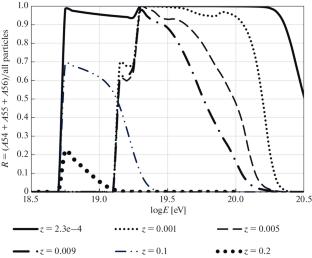地球附近超高能宇宙射线中的铁核
IF 0.48
Q4 Physics and Astronomy
Bulletin of the Russian Academy of Sciences: Physics
Pub Date : 2025-07-15
DOI:10.1134/S1062873825711353
引用次数: 0
摘要
假设超高能量宇宙射线来自河外,讨论了能量在1019ev以上的宇宙铁核从源向银河系的传播。在河外空间,宇宙核与背景辐射相互作用,不可避免地分裂。分析了到达地球的铁核的比例,以及它的能量如何取决于与宇宙射线源的距离。发现铁核的能量可以用来确定对其源距离的限制。本文章由计算机程序翻译,如有差异,请以英文原文为准。

Iron Nuclei in Ultra-High Energy Cosmic Rays Near the Earth
The propagation of cosmic iron nuclei with energies above 1019 eV from their sources to the Galaxy is discussed by assuming that cosmic rays at ultra-high energies are of extragalactic origin. In extragalactic space, cosmic nuclei interact with background emissions and inevitably fragment. An analysis is performed of the fraction of iron nuclei reaching the Earth and how its energy depends on the distance from cosmic ray sources. It is found that energies of iron nuclei can be used to determine restriction on the distances from their sources.
求助全文
通过发布文献求助,成功后即可免费获取论文全文。
去求助
来源期刊

Bulletin of the Russian Academy of Sciences: Physics
Physics and Astronomy-Physics and Astronomy (all)
CiteScore
0.90
自引率
0.00%
发文量
251
期刊介绍:
Bulletin of the Russian Academy of Sciences: Physics is an international peer reviewed journal published with the participation of the Russian Academy of Sciences. It presents full-text articles (regular, letters to the editor, reviews) with the most recent results in miscellaneous fields of physics and astronomy: nuclear physics, cosmic rays, condensed matter physics, plasma physics, optics and photonics, nanotechnologies, solar and astrophysics, physical applications in material sciences, life sciences, etc. Bulletin of the Russian Academy of Sciences: Physics focuses on the most relevant multidisciplinary topics in natural sciences, both fundamental and applied. Manuscripts can be submitted in Russian and English languages and are subject to peer review. Accepted articles are usually combined in thematic issues on certain topics according to the journal editorial policy. Authors featured in the journal represent renowned scientific laboratories and institutes from different countries, including large international collaborations. There are globally recognized researchers among the authors: Nobel laureates and recipients of other awards, and members of national academies of sciences and international scientific societies.
 求助内容:
求助内容: 应助结果提醒方式:
应助结果提醒方式:


